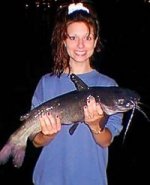TomZ's Catfish Tactics
 I like catching cats...especially
channel cats.
I like catching cats...especially
channel cats.
But to tell you the truth, my son Tom is a better catfisherman than I am. That's Tom at the left and below-right. Tom's little sister seems to have inherited the same catfish cunning has Tom, as can be seen from the picture at the end of this article.
As a teenager, Tom used to catch white cats from the Housatonic River impoundments in Connecticut. Today, he uses the same techniques to catch white cats and channel cats from Lake Champlain in Vermont.
His technique isn't complex...just good old common sense. The cat's sense of smell/taste gives it a competitive advantage over sight feeders from dusk through the first few hours of darkness. While fish that rely almost entirely on eyesight are still adjusting to the change in light level, cats with their ability to find food through its chemical signature, have no adjustment period to contend with. So whenever possible, Tom concentrates his catfishing around the times when he can take advantage of cats taking advantage of bleary-eyed bait under changing/low light conditions.
Tom prefers fresh fish meat over bloodbait and stinkbait concoctions. "Chicken guts and cornmeal mixes catch cats," he says, "but not nearly as well as a hunk of real fish meat." So Tom usually starts his catfishing outing before dark, using a small hook or tiny jig baited with a morsel of garden worm, bread, or whatever else is handy, to catch a few of whatever small fish will bite. It might be fallfish, roach or whatever's abundant. The cats aren't fussy, and neither is Tom. He scales and fillets these baitfish, and uses the fillets to catch the cats.
Depending on the depth and the speed of the current, somewhere between a single split shot and a half-ounce (or so) of lead is attached to the line a couple feet above a sharp, #1 (or larger) hook. The cutbait is impaled on the hook, being sure to pass the hook through the skin. "I used to use a sliding sinker rig," Tom explains, "but it's a lot more trouble to rig, and as long as I keep the weight light, 15 and 20 pound fish don't seem to even notice it."
If it's rained recently, Tom might fish around an incoming stream mouth. The same advantage that cats have around nightfall holds true when the water turns off-colored due to run-off, so the cats will move into heavy run-off areas to take advantage of it. If there's no heavy run-off situation to take advantage of, Tom looks for eddies in the main flow, and fishes around them. In non-current or low current situations, he searches out shallow sandbars bordering deep water.

Cats like snags and snaggy areas. Boulders, logs, whatever. Try to get your bait around, but just upstream of sizable snags.
Since the cats follow the scent/taste dispersed in the water to their meal, it's important, when fishing current, to keep the bait upstream of the spot that the fish are suspected to be holding. The bait's chemical signature only flows one direction, so it can only reach and attract fish that are downstream of it.
